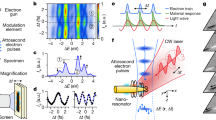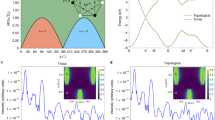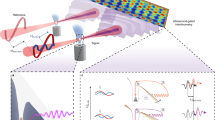Abstract
Attosecond science capitalizes on the extreme nonlinearity of strong fields—driven by few-cycle pulses—to attain attosecond temporal resolution and give access to the electron motion dynamics of matter in real time. Here we measured the relative electronic delay response of a dielectric system triggered by a strong field of few-cycle pulses to be of the order of a few hundred attoseconds. Moreover, we exploited the electronic response following the strong driver field to demonstrate all-optical light-field-sampling methodology with attosecond resolution. This methodology provides a direct connection between the driver field and induced ultrafast dynamics in matter. Also, we demonstrate control of electron motion in a dielectric using synthesized light waveforms. This on-demand control of electron motion paves the way for establishing long-anticipated ultrafast switches and quantum electronics. This advancement promises to increase the limiting speed of data processing and information encoding to rates that exceed one petabit per second, opening a new realm of information technology.
This is a preview of subscription content, access via your institution
Access options
Access Nature and 54 other Nature Portfolio journals
Get Nature+, our best-value online-access subscription
$29.99 / 30 days
cancel any time
Subscribe to this journal
Receive 12 print issues and online access
$209.00 per year
only $17.42 per issue
Buy this article
- Purchase on Springer Link
- Instant access to full article PDF
Prices may be subject to local taxes which are calculated during checkout




Similar content being viewed by others
Data availability
Source data are provided with this paper. The data that support the plots within this paper and other findings of this study are available from the corresponding author upon reasonable request.
Code availability
The analysis codes that support the findings of this study are available from the corresponding author upon reasonable request.
References
Corkum, P. B. & Krausz, F. Attosecond science. Nat. Phys. 3, 381–387 (2007).
Krausz, F. & Ivanov, M. Attosecond physics. Rev. Mod. Phys. 81, 163 (2009).
Nisoli, M. & Sansone, G. New frontiers in attosecond science. Prog. Quantum Electron. 33, 17–59 (2009).
Krausz, F. Electrons in Motion: Attosecond Physics Explores Fastest Dynamics (World Scientific, 2019).
Calegari, F. et al. Ultrafast electron dynamics in phenylalanine initiated by attosecond pulses. Science 346, 336–339 (2014).
Sansone, G. et al. Electron localization following attosecond molecular photoionization. Nature 465, 763–766 (2010).
Schlaepfer, F. et al. Attosecond optical-field-enhanced carrier injection into the GaAs conduction band. Nat. Phys. 14, 560–564 (2018).
Gaal, P. et al. Internal motions of a quasiparticle governing its ultrafast nonlinear response. Nature 450, 1210–1213 (2007).
Ghimire, S. et al. Observation of high-order harmonic generation in a bulk crystal. Nat. Phys. 7, 138–141 (2011).
Vampa, G. et al. Strong-field optoelectronics in solids. Nat. Photon. 12, 465–468 (2018).
Luu, T. T. et al. Extreme ultraviolet high-harmonic spectroscopy of solids. Nature 521, 498–502 (2015).
You, Y. S. et al. Laser waveform control of extreme ultraviolet high harmonics from solids. Opt. Lett. 42, 1816–1819 (2017).
You, Y. S. et al. High-harmonic generation in amorphous solids. Nat. Commun. 8, 724 (2017).
Li, J. et al. Attosecond science based on high harmonic generation from gases and solids. Nat. Commun. 11, 2748 (2020).
Wachter, G. et al. Ab initio simulation of electrical currents induced by ultrafast laser excitation of dielectric materials. Phys. Rev. Lett. 113, 087401 (2014).
Khurgin, J. B. Optically induced currents in dielectrics and semiconductors as a nonlinear optical effect. J. Opt. Soc. Am. B 33, C1–C9 (2016).
Yakovlev, V. S., Kruchinin, S. Y., Paasch-Colberg, T., Stockman, M. I. & Krausz, F. Ultrafast Dynamics Driven by Intense Light Pulses: From Atoms to Solids, from Lasers to Intense X-rays Ch. 12 (Springer, 2016).
Yamada, S., Noda, M., Nobusada, K. & Yabana, K. Time-dependent density functional theory for interaction of ultrashort light pulse with thin materials. Phys. Rev. B 98, 245147 (2018).
Yabana, K., Sugiyama, T., Shinohara, Y., Otobe, T. & Bertsch, G. F. Time-dependent density functional theory for strong electromagnetic fields in crystalline solids. Phys. Rev. B 85, 045134 (2012).
Sato, S. A., Yabana, K., Shinohara, Y., Otobe, T. & Bertsch, G. F. Numerical pump-probe experiments of laser-excited silicon in nonequilibrium phase. Phys. Rev. B 89, 064304 (2014).
Paasch-Colberg, T. et al. Sub-cycle optical control of current in a semiconductor: from the multiphoton to the tunneling regime. Optica 3, 1358–1361 (2016).
Schultze, M. et al. Controlling dielectrics with the electric field of light. Nature 493, 75–78 (2013).
Schiffrin, A. et al. Optical-field-induced current in dielectrics. Nature 493, 70–74 (2013).
Apalkov, V. & Stockman, M. I. Theory of dielectric nanofilms in strong ultrafast optical fields. Phys. Rev. B 86, 165118 (2012).
Lucchini, M. et al. Unravelling the intertwined atomic and bulk nature of localised excitons by attosecond spectroscopy. Nat. Commun. 12, 1021 (2021).
Paasch-Colberg, T. et al. Solid-state light-phase detector. Nat. Photon. 8, 214–218 (2014).
Sederberg, S. et al. Attosecond optoelectronic field measurement in solids. Nat. Commun. 11, 430 (2020).
Korobenko, A. et al. Femtosecond streaking in ambient air. Optica 7, 1372–1376 (2020).
Mitrofanov, A. V. et al. Optical detection of attosecond ionization induced by a few-cycle laser field in a transparent dielectric material. Phys. Rev. Lett. 106, 147401 (2011).
Langer, F. et al. Few-cycle lightwave-driven currents in a semiconductor at high repetition rate. Optica 7, 276–279 (2020).
Autler, S. H. & Townes, C. H. Stark effect in rapidly varying fields. Phys. Rev. 100, 703–722 (1955).
Wirth, A. et al. Synthesized light transients. Science 334, 195–200 (2011).
Hassan, M. T. et al. Optical attosecond pulses and tracking the nonlinear response of bound electrons. Nature 530, 66–70 (2016).
Hassan, M. T. et al. Invited article: attosecond photonics: synthesis and control of light transients. Rev. Sci. Instrum. 83, 111301 (2012).
Weiner, A. M. Ultrafast optical pulse shaping: a tutorial review. Opt. Commun. 284, 3669–3692 (2011).
Acknowledgements
This project is funded by the Gordon and Betty Moore Foundation grant GBMF7938 to M.T.H. This material is also based on work partially supported by the Air Force Office of Scientific Research under award no. FA9550-19-1-0025. This research is partly supported by JST-CREST under grant no. JP-MJCR16N5 to K.Y., by MEXT Quantum Leap Flagship Program (MEXT Q-LEAP) under grant no. JPMXS0118068681. Calculations are carried out at Oakforest-PACS at JCAHPC with support through the HPCI System Research Project (project ID: hp20034) and Multidisciplinary Cooperative Research Program in CCS, University of Tsukuba.
Author information
Authors and Affiliations
Contributions
H.A. and D.H. conducted the experiments and analysed the data. S.Y. and K.Y. carried out the simulations and calculations. V.P. designed and measured the optics of the LFS. M.T.H. conceived, supervised and directed the study. All the authors discussed the results and their interpretations and wrote the manuscript.
Corresponding author
Ethics declarations
Competing interests
The authors declare no competing interests.
Additional information
Peer review information Nature Photonics thanks Shambhu Ghimire and the other, anonymous, reviewer(s) for their contribution to the peer review of this work
Publisher’s note Springer Nature remains neutral with regard to jurisdictional claims in published maps and institutional affiliations.
Supplementary information
Supplementary Information
Supplementary Figs. 1–5 and Sections 1–4.
Source data
Source Data Fig. 2
Statistical source data for Fig. 2.
Source Data Fig. 3
Statistical source data for Fig. 3.
Source Data Fig. 4
Statistical source data for Fig. 4.
Rights and permissions
About this article
Cite this article
Hui, D., Alqattan, H., Yamada, S. et al. Attosecond electron motion control in dielectric. Nat. Photon. 16, 33–37 (2022). https://doi.org/10.1038/s41566-021-00918-4
Received:
Accepted:
Published:
Issue Date:
DOI: https://doi.org/10.1038/s41566-021-00918-4
This article is cited by
-
Real-time tracking of coherent oscillations of electrons in a nanodevice by photo-assisted tunnelling
Nature Communications (2024)
-
Unconventional light - matter interaction in the response-time region of unionized bound electrons
Applied Physics B (2024)
-
Interference of the Electric and Envelope Areas of Ultrashort Light Pulses in Quantum Systems
Radiophysics and Quantum Electronics (2024)
-
Attosecond magnetization dynamics in non-magnetic materials driven by intense femtosecond lasers
npj Computational Materials (2023)
-
Dynamic optical response of solids following 1-fs-scale photoinjection
Nature (2023)



